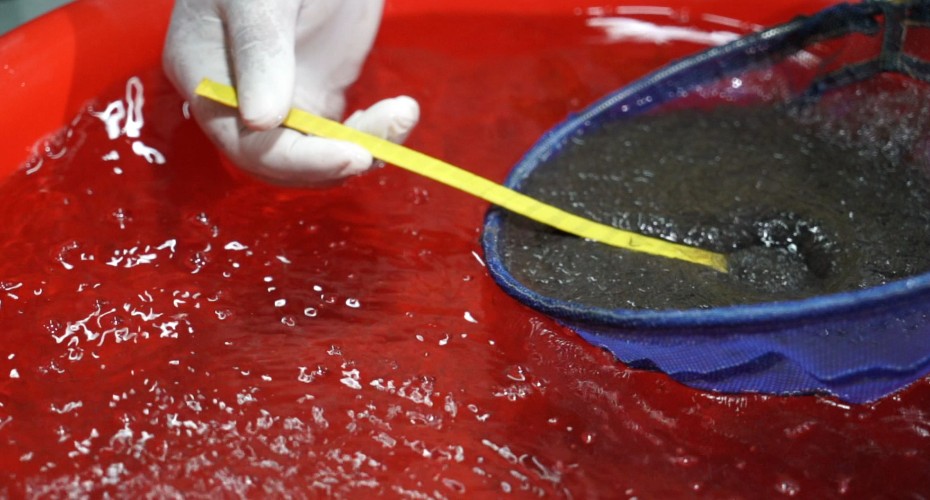We would be happy to discuss our project further. Please contact the UK or Bangladesh team:
Dr Kelly Thornber, University of Exeter, UK:
k.thornber@exeter.ac.uk
Dr Md Meezanur Rahman, WorldFish, Bangladesh:
Muhammad.Rahman@cgiar.org
Information for hatcheries
Frequently asked questions
Pathogens can enter into hatcheries through a number of routes:
- Diseased broodstock
- Vehicles used for transportation that have not been cleaned or disinfected properly.
- Equipment and tools that have not been cleaned and disinfected properly.
- People working at or visiting the hatcheries who have not washed their hands, changed into clean/protective clothing or disinfected footwear.
- Animals, pests or insects
- Minimize the levels of pathogens entering and spreading around hatcheries, which lowers the risk of disease.
- Increase hatchability rate.
- Increase hatchery profitability.
- Improved environmental and working conditions (e.g. reduced smell and dust) for workers and less chance of workers getting sick.
- Avoid pathogen transmission from hatcheries to farms.
Our training video 1 (“Introduction to biosecurity”) explains this in more detail.
- People can bring pathogens to hatcheries on their vehicles, clothes, footwear, hands and other material they are carrying.
- People that have been in contact with unhealthy or diseased shrimp (which can carry high levels of shrimp pathogens) are a very high biosecurity risk and should not be allowed into your hatchery.
- Before entering hatcheries, vehicles should be disinfected and people should be requested to wash their hands, change footwear and clothing.
Pests should be kept out of hatcheries because they can:
- Carry pathogens.
- Spread pathogens around the hatchery
- Damage electric wires and equipment.
- Improper cleaning and disinfection results in the growth of bacteria and other potential pathogens within the hatchery.
- Disinfection serves to kill any remaining microbes that have not been removed through cleaning.
- In the same way that disinfectants kill pests and unwanted microbes, they also kill animals and plants in the local environment.
Disinfection might not work if:
- Inappropriate use of disinfectant, e.g. incorrect dilution or method of application.
- Use of poor quality water to dilute disinfectant.
- Insufficient cleaning prior to disinfection.
Our training video 3(“Stop pathogens growing in your hatchery”) explains this in more detail..
Most cleaning and disinfecting agents are poisonous and carry special warnings. Therefore, when using these chemicals, full personal protective equipment is recommended.
- Protective clothing including long trousers and long-sleeved top.
- Rubber boots.
- A respirator or mask.
- Goggles or protective eye wear.
- A hat.
- Rubber gloves.
Note: Remember to wash your hands, boots, and protective eye wear immediately after handling disinfectant chemicals, to avoid contaminating other surfaces with them. You should:
- Throw away the rubber gloves, or wash them if they are not disposable.
- Change out of the clothes that have been exposed, and wash them.
- Dispose of excess disinfectant properly.
- Carefully clean and rinse sprayers and other equipment used to mix and spray disinfectant.
- Currently, there are many chemicals used in hatcheries. It should be noted that all chemical disinfectants can be harmful and toxic to humans if they are not used properly.
- People can potentially be harmed by contact with chemicals or inhaling chemical fumes. Some chemicals are also highly flammable. Proper precautions should be taken to prevent exposure and work in properly ventilated room.
- Animal health
- Water quality
- Feeding
- Visitor log sample
We have developed monitoring sheets that hatcheries can download and use for monitoring, and these are explained more in video 7 (“Monitor and manage your hatchery risks”).
Good biosecurity practices can reduce the level of pathogens entering a hatchery, but sometimes pathogens can still enter.
If animals are healthy they are much better at resisting pathogens and preventing disease. This will also result in good quality PL that performs better at the grow-out stage. Therefore, maintaining good animal health is an essential part of good biosecurity practice and helping to optimize both productivity and profitability.
Our training video 3 (“Stop pathogens growing in your hatchery”) explains this in more detail.
The movement of animals and equipment can increase the spread of pathogens.
Each animal has microbes on it (good and bad ones) but some microbes that do not affect one life stage can cause disease in other life stages. Equipment may carry microbes from one area of the hatchery to another.
Our training video 4 (“Stop pathogens spreading around your hatchery”) explains this in more detail.
Further information on hatchery biosecurity
Bengali
Shrimp Hatchery Standard Operating Procedures, produced by the Department of Fisheries, Bangladesh, in collaboration with Solidaridad.
Please contact the Department of Fisheries to obtain a copy.
English
Better management practices manual for black tiger shrimp (Penaeus monodon) hatcheries in Viet Nam. Produced by ENACA in 2005


